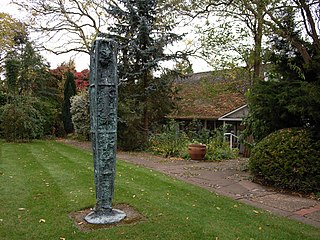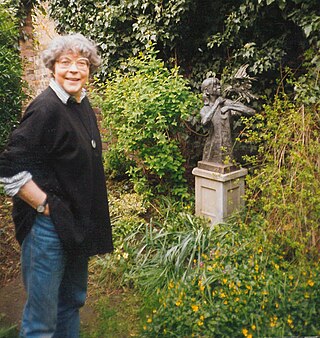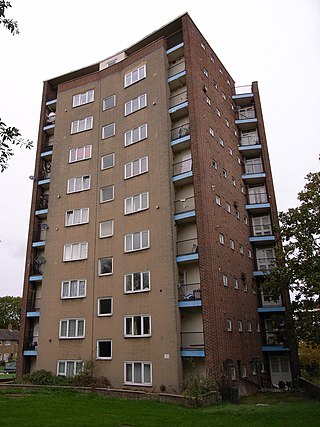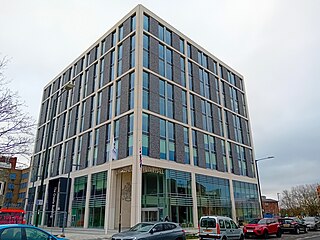
Birmingham Central Library was the main public library in Birmingham, England, from 1974 until 2013, replacing a library opened in 1865 and rebuilt in 1882. For a time the largest non-national library in Europe, it closed on 29 June 2013 and was replaced by the Library of Birmingham. The building was demolished in 2016, after 41 years, as part of the redevelopment of Paradise Circus by Argent Group. Designed by architect John Madin in the brutalist style, the library was part of an ambitious development project by Birmingham City Council to create a civic centre on its new Inner Ring Road system; however, for economic reasons significant parts of the master plan were not completed, and quality was reduced on materials as an economic measure. Two previous libraries occupied the adjacent site before Madin's library opened in 1974. The previous library, designed by John Henry Chamberlain, opened in 1883 and featured a tall clerestoried reading room. It was demolished in 1974 after the new library had opened.

Harlow is a town and local government district located in the west of Essex, England. Founded as a new town, it is situated on the border with Hertfordshire, Harlow occupies a large area of land on the south bank of the upper Stort Valley, which has been made navigable through other towns and features a canal section near its watermill.

Epping Forest District is a local government district in Essex, England. It is named after the ancient woodland of Epping Forest, a large part of which lies within the district. The district covers northeastern parts of the urban area of London, including the suburban towns of Epping, Loughton, Waltham Abbey, Chigwell, and Buckhurst Hill, as well as rural areas beyond it. The district is situated in the west of the county, bordering north-eastern Greater London.
Sir Frederick Ernest Gibberd CBE was an English architect, town planner and landscape designer. He is particularly known for his work in Harlow, Essex, and for the BISF house, a design for a prefabricated council house that was widely adopted in post-war Britain.

Sir Arnold Joseph Philip Powell, usually known as Philip Powell, was an English post-war architect.

Te Ngākau Civic Square is a public square in central Wellington, New Zealand, between the Wellington central business district to the north and the Te Aro entertainment district to the south. The square is bounded by Jervois Quay, Harris Street, Victoria Street and Wakefield Street

Harlow Town Park is a 164-acre (66 ha) public park in Harlow, Essex, England. The park is one of the largest urban parks in Britain. It includes multiple gardens, a petting zoo named the Pets' Corner, a bandstand, and the Spurriers House Café. It opened in 1957 and was designed by two of the most important figures in 20th Century landscape architecture in Britain: Frederick Gibberd and Sylvia Crowe. Its importance was recognised by Historic England on 18 August 2020 when it was added to the Register of Historic Parks and Gardens as Grade II. The park is set in and around the valley of Netteswell Cross, which includes a stream and a small historic settlement which retains a high level of original character. Several of the buildings are Grade II listed including 6 School Lane, Greyhound Public House, Hill Hall Farmhouse, Hoppitts, and Marshgate Farmhouse. These buildings range in age from the 16th to the late 19th centuries. Harlow Town Park received a large £2.8m grant for renovations in 2014, which were completed in 2016. The park has been awarded a Green Flag on six occasions, recognising the quality of green space management. In 2019 the Park was voted among the most popular 10 parks in the country in the Green Flag People's Choice award.
William George Mitchell was an English sculptor, artist and designer. He is best known for his large scale concrete murals and public works of art from the 1960s and 1970s. His work is often of an abstract or stylised nature with its roots in the traditions of craft and "buildability". His use of heavily modelled surfaces created a distinctive language for his predominantly concrete and glass reinforced concrete (GRC) sculptures. After long years of neglect, many of William Mitchell's remaining works in the United Kingdom are now being recognised for their artistic merit and contemporary historic value, and have been granted protective, listed status.

Gibberd Garden is a garden in Harlow, Essex, England, which was created by Sir Frederick Gibberd and his wife Patricia Gibberd. They designed the garden and added sculptures, ceramic pots and architectural salvage from 1972 till his death in 1984.

Harlow District Council is the local authority for Harlow in Essex, England. Harlow is a non-metropolitan district, covering just the town of Harlow itself. The council generally styles itself Harlow Council.

Gerda Ursula Rubinstein was a Dutch sculptor of figures, birds and animals based in England since 1959 or 1960.
Gerard Thomas Goalen was a British architect who specialised in church architecture and was influenced by continental models and the Liturgical Movement. He was one of the most important architects of the Catholic Modernist movement in the United Kingdom during the 20th century.
Harlow Art Trust (HAT) is a registered charity based in Harlow, Essex that was set up in the 1950s to acquire and display sculptures. Having collected many works over the years it now comprises a nationally significant collection located throughout the town. HAT was set up by the lead architect of Harlow New Town Frederick Gibberd. Gibberd wanted the New Town to be a place where people who might not normally have access to art could enjoy great sculptures by great artists on every street corner. Consequently, almost all of Harlow's sculpture collection is in the open air, in shopping centres, housing estates and parks around the town.

The 1996 Harlow District Council election took place on 2 May 1996 to elect members of Harlow District Council in Essex, England. This was on the same day as other local elections. The Labour Party retained control of the council, which it had held continuously since the council's creation in 1973.

The Lawn is a mid-twentieth-century low-rise building located on the outskirts of Old Harlow, to the east of the town of Harlow, Essex, England.

Crawley Town Hall is a municipal structure in The Boulevard, Crawley, West Sussex, England. It was completed in 2023 and serves as the headquarters of Crawley Borough Council.

Our Lady of Fatima's Church is a Roman Catholic parish church in Harlow, Essex, England. It was designed between 1953 and 1954 by Gerard Goalen and was one of the earliest churches in England where the design was influenced by the Liturgical Movement. Construction did not begin until 1958 and the church was consecrated in 1960. Notable for its highly decorated interior, the church contains examples of dalle de verre glasswork, which are considered the first major instance of the style in Britain. This work was undertaken by Dom Charles Norris of Buckfast Abbey. Goalen designed the church in a Modernist style, influenced by European examples. It is a Grade II* listed building.

Thurrock Town Hall is a newest part of municipal complex in New Road in Grays, Essex, a town in England. The complex accommodates the offices and meeting place of Thurrock Council.

Epping Civic Offices is a municipal building in Epping, Essex, a town in England. The building, which accommodates the headquarters of Epping Forest District Council, is a grade II listed building.
















